Assignment 5 Report
Evaluation of Interface Application
Introduction
“Virtual Bartending Academy is your loyal VR bartending instructor, turning anyone into a skilled bartender through immersive, feedback-rich training, all without spilling a drop.”
Amidst rapid technological advancements, traditional training methods are evolving. Virtual Reality (VR) offers a promising alternative for skill-based professions like bartending. Formal bartending training often faces issues like limited practice time and resource waste. The 'Virtual Bartending Academy,' developed on the Unity platform, addresses these challenges. This VR app simulates real-world bartending scenarios, allowing users to practice without wasting resources and benefit from real-time feedback. This report discusses the benefits and potential of this innovative VR training solution and the process our team members produced.
Technical Development
There were four main areas of development for this application: Environment, Model Design, User Interface and Interaction.
For this application, a key to provide correct functionality for the project was the ‘Unity-Simple-Liquid’ package designed by Macoron from GitHub (link https://github.com/Macoron/Unity-Simple-Liquid). This allowed the application to contain basic liquid physics capabilities. The package included three main scripts, which were applied to various liquid containers on the project. The first was called Liquid Container. The function of this script is to control all the properties of the liquid inside the specific object. The Split Controller script manages the outflow of the fluid from the container. The Endless Container script allows the liquid container to have infinite liquid inside, which is especially useful so the user is not hindered by running out of a particular substance.
There were scripts made to go from the main menu scene into each other level using SceneManagement.LoadScene function, the creation of the main menu and its functionality was created by closely following the Youtube tutorial: "Unity VR Development for Oculus Quest: Main Menu" by RealaryVR (link www.youtube.com/watch?v=Xhz7cW5dbyY)
3D Content
Distance Grabber Hands
The distance grabber hands (found in the Oculus integration package from the Unity asset store) are applied to the player controller to allow the user to interact with (pick up/release) objects. They enable the user to pour drinks, mix ingredients, and add garnishes.

Pirate Tavern
The 3D scene consists of a large tavern. PollyPrivateers created the “Pirate Tavern” environment on the Unity store. The tavern environment is an ambient backdrop to set the scene for the user as they make drinks. The environment is comprised of walls, windows, ceilings, tables, chairs, a roaring fireplace, and miscellaneous décor.

The lighting from this package also features heavily in our application. These lighting elements are made up of torches, lanterns, and the fireplace. These add visibility for the user.
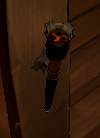

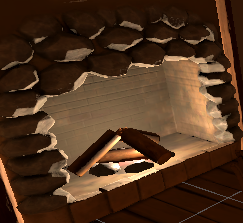
The bar from this package functions as our main working surface. All ingredients and receptacles sit atop it.
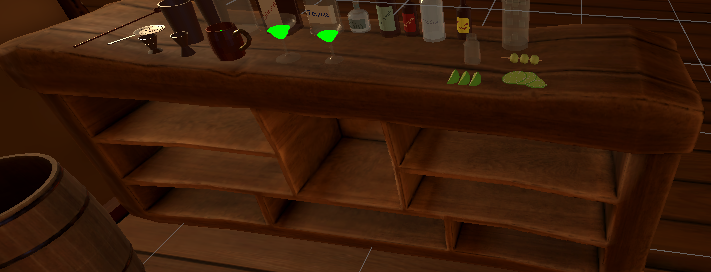
The shelf stands behind the bar and extra bottles sit upon it. These are not functional; they are for setting the scene.
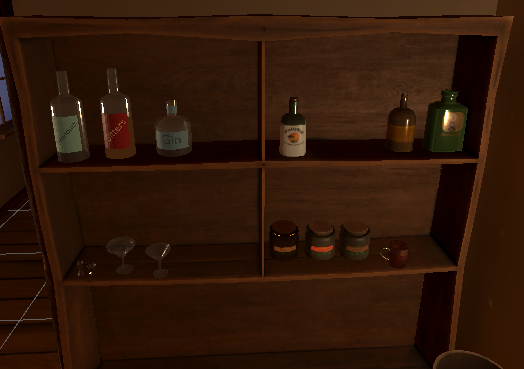
Bar specific items
Liquor bottles are necessary for the application, as liquor is the main material bartenders work with. These bottles are used for pouring liquid from. We have made every bottle necessary for the three drinks we chose to include.
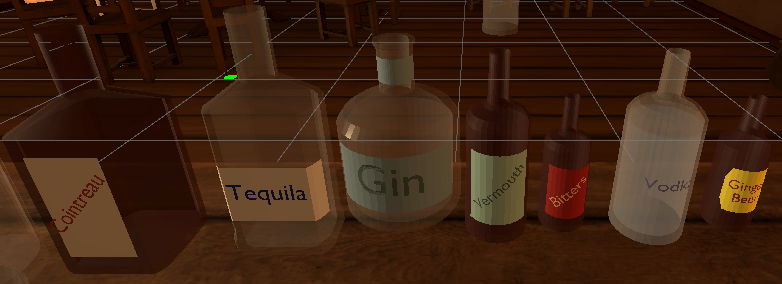
The martini glass, margarita glass, and Moscow mule mug are receptacles for liquid. These are used for presenting the three different drinks, and can be poured into. The designs are based on glasses and cups that a bartender would use to make these drinks in the real world.
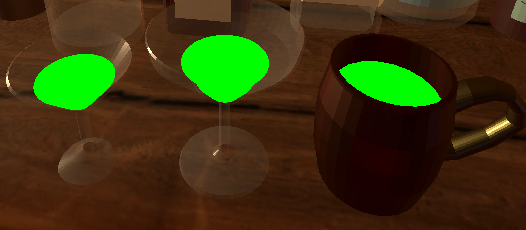
The mixing glass and a mixing spoon are used to mix the fluid. The user can pour liquid into the mixing glass and stir it using the spoon. These are common bartending tools and crucial for many common drinks.
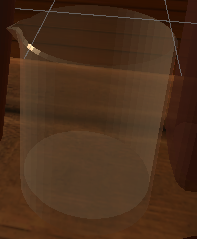

The strainer is used to pour drinks, ensuring only liquid can flow through. Strainers are used in bartending very often. The user can pick the strainer up and pour liquids through it. This strainer is used for the margarita and the martini.
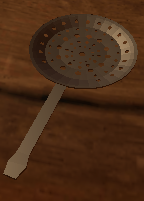
The lime wedges, slices, and olive toothpicks were created as garnishes for our drinks. The lime wedges are for the Moscow mule, the olives are for the martini, and the lime slices are for the margarita. These help create the finishing touches for the three drinks.

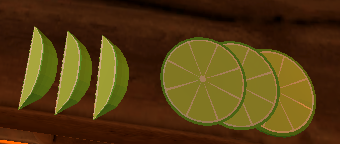
The jiggers are used for measuring alcohol. There are two types, and they are used to provide different measurements. The taller jigger in our application can be used from both ends, as the bartender in our reference videos used both sides.
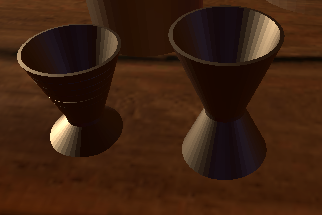
Ice is used in the making of every drink. Bartenders work with ice cubes daily, and it is important to include them in our application.

Usability Testing
Design and Plan
Usability testing can be broken down into five components. These are learnability, efficiency, memorability, errors, and satisfaction (J Nielsen, 2012). These components are built atop the ISO 9241 standard of 1998, which includes effectiveness, efficiency, and satisfaction (Motyl et al., 2022). Our usability testing is based on the five components outlined by Nielsen, who is highly respected in the field of usability testing. In his 2012 article, Nielsen also mentioned another aspect, utility (whether the application meets the needs that we set out to fulfil). This is not necessarily an aspect of usability but is extremely relevant to our application as it has a specific purpose, and it will be considered in our testing process.
We plan to gather the users and have them try the application. After each person has finished testing, they will receive a questionnaire, giving us feedback that we can use to improve the application. The questionnaire includes questions relating to each of the five components of usability, as well as a question relating to utility. Most of these questions are multiple-choice. At the end of the questionnaire, there are a few open-ended questions, intended for users to give extra feedback and suggestions. For the memorability component, it would be more effective to test the users twice (the second occasion after a time has passed). We are unable to do this, due to time constraints.
Recruitment
Within the intricate domain of bartending, the right selection for usability testing is pivotal in garnering insightful feedback. Our primary focus is on individuals with a discerning eye for detail and a keen interest in technology. This encompasses both seasoned professionals and novices who are just beginning to explore this technological realm. Initially, our recruitment strategy was concentrated on students, particularly those pursuing similar fields of study and showing an inclination towards bartending careers. Their fresh insights were expected to furnish us with nuanced perspectives. Yet, unforeseen time challenges necessitated a shift in our approach. We pivoted towards a more intimate strategy, turning to our close friends for input. Notably, Will, a friend of our team member Lily, generously contributed his time, offering invaluable feedback. We're profoundly thankful for his involvement. To diversify our feedback and expedite the process, we introduced intriguing scenarios in our tests and approached random passers-by for participation.
Protocol of the testing
First, we will provide each tester with an overview of our application, focusing on its purpose and structure. They must know that our main goal is to evaluate the application's performance. All feedback, whether positive or negative, is priceless to us. Before initiating the process, we ensure that each participant fully understands the procedure and voluntarily agrees.
To get real and comprehensive insights, we carefully consider the tester's reactions during the sessions. We not only record their verbal feedback and comments, but we are also ready to provide immediate assistance and respond to unforeseen circumstances.
After the test, participants received a questionnaire. This structured approach to gathering feedback allows us to delve deeper into the user experience, pinpointing its strengths and potential areas for enhancement.
Report of the findings
Summary of results A brief overview of the testing process Briefly reiterate how the test is conducted Detailed findings and recommendations
All 5 participants were able to use the VR tools to achieve the goal effectively; make a drink of their choice (out of Moscow Mule, Martini and Margarita)
| Difficult | A little difficult | Neither easy or difficult | A little easy | Easy | |
| How easy was it to get accustomed to the application | 0 | 0 | 1 | 2 | 2 |
| Slowly | A little slowly | Neither slowly or quickly | Quite quickly | Quickly | |
| How quickly did you feel you were able to perform tasks? | 0 | 1 | 1 | 2 | 1 |
| Unlikely | A little unlikely | Neither unlikely or likely | Fairly likely | Likely | |
| How likely are you to remember how to use the application after a period of disuse | 0 | 0 | 3 | 1 | 1 |
| Hated | Disliked | Neither liked nor disliked | Liked | Loved | |
| How much did you enjoy using the application | 0 | 0 | 3 | 2 | 0 |
| Ineffective | Slightly ineffective | neither effective nor ineffective | Slightly effective | Effective | |
| How effective do you feel the application would be for training bartenders | 2 | 2 | 1 | 0 | 0 |
Analyses of the findings
From the findings and verbal feedback, it can be clearly seen that although the experience was enjoyable and easy to learn, our original goal was not met. This is due to not implementing as much as we would have liked and instead missing out on some features which would help aid in it feeling a lot more effective such as the HUD or a rating and a timer.
Addressing the Results of the Usability Testing
Due to some unlucky circumstances, we could not implement as many of the changes we wanted, as we ran out of time, but we could make a HUD for each drink level which displays the recipe. This change is a large step in the right direction for allowing the user to follow instructions instead of it being a sandbox.
References
Report References
Chinthammit, W. and Wells, L. (no date) KIT208/724 Virtual and Mixed Reality Technology Week 10: Usability Testing. Available at: https://mylo.utas.edu.au/d2l/le/content/598980/viewContent/5101712/View (Accessed: 22 October 2023).
Kamińska, D., Zwoliński, G. and Laska-Leśniewicz, A. (2022) Usability testing of virtual reality applications-the pilot study, Sensors (Basel, Switzerland). Available at: https://www.ncbi.nlm.nih.gov/pmc/articles/PMC8963057/ (Accessed: 21 October 2023).
Nielsen, J. (2012) Usability 101: Introduction to usability, Nielsen Norman Group. Available at: https://www.nngroup.com/articles/usability-101-introduction-to-usability/ (Accessed: 22 October 2023).
Pavuna, A. (2019) A fundamental guide to user testing in virtual reality, Medium. Available at: https://medium.com/ostmodern/a-fundamental-guide-to-user-testing-in-virtual-reality-a71c85c764c0 (Accessed: 21 October 2023).
Strohmaier, R. et al. (2022) Usability testing of mixed reality scenarios: A hands-on report, IntechOpen. Available at: https://www.intechopen.com/chapters/83920 (Accessed: 21 October 2023).
Development References
Oculus integration: Integration (2023) Unity Asset Store. Available at: https://assetstore.unity.com/packages/tools/integration/oculus-integration-82022.
Pirate tavern: 3D fantasy (2018) Unity Asset Store. Available at: https://assetstore.unity.com/packages/3d/environments/fantasy/pirate-tavern-113463.
Beginner cocktails: Moscow Mule (2017). Steve the Bartender. 3 May. Available at: https://www.youtube.com/watch?v=J7X-AeGHPcE
Beginners Guide for Making Martinis (2020) YouTube. Available at: https://www.youtube.com/watch?v=75k7dsINNQ0&t=117s
Classic margarita cocktail recipe (2017) YouTube. Available at: https://www.youtube.com/watch?v=XhXgmkP1r3c
ChatGPT
Used to assist with the creation of a script to cut limes: https://chat.openai.com/share/9751f9ae-1e63-40ca-8dd6-cec7d519fea7
Used to assist with liquid physics: https://chat.openai.com/c/9a341c7e-14e5-4228-a295-f85b3a95f98a
[RealaryVR]. ([2022]). [Unity VR Development for Oculus Quest: Main Menu]. YouTube. Retrieved from [www.youtube.com/watch?v=Xhz7cW5dbyY]
Audio for background bar noises
Leave a comment
Log in with itch.io to leave a comment.